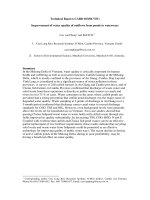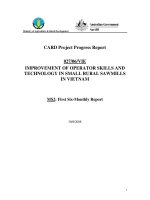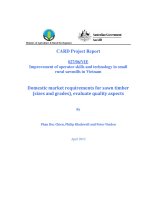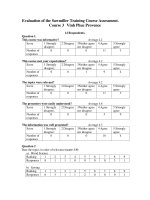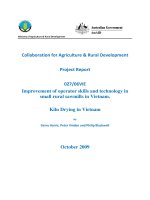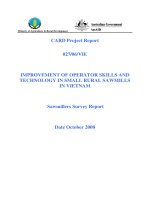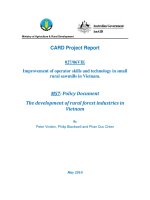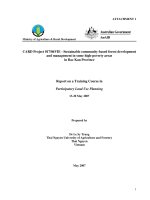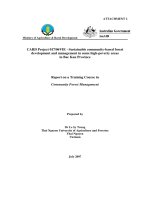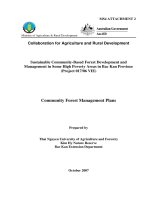Báo cáo khoa học nông nghiệp " Recycling of fishpond waste for rice cultivation in the Cuu Long delta, Vietnam " ppt
Bạn đang xem bản rút gọn của tài liệu. Xem và tải ngay bản đầy đủ của tài liệu tại đây (44.65 KB, 9 trang )
1
Recycling of fishpond waste for rice cultivation
in the Cuu Long delta, Vietnam
Cao van Phung
1
, Nguyen be Phuc
1,2
, Tran kim Hoang
2
and Bell R.W.
3
1. Cuu Long Rice Research Institute, O’Mon, Cantho Province, Vietnam.
Email:
2. An Giang University, Long Xuyen, An Giang Province, Vietnam
3. Murdoch University, Murdoch 6150, Australia
Cat fish (Pangasianodon hypophthalmus) production has expanded to over one
million tonnes in 2007 and 2008 from ponds that cover about 5,000 ha in the Cuu
Long delta, Vietnam. From these ponds, large quantities of liquid and solid waste
are discharged to waterways without treatment. Consequently, the pollution of
canals or rivers by loading of fishpond waste, rich in nutrients (especially nitrogen
and phosphorus) has emerged as a major concern. A survey in the dry season
2007 of 8 paired fields showed that rice yield in 8 paddies receiving waste from
fishpond was 1 t/ha higher than in another 8 paddies that did not use wastes.
Field experiments were conducted starting from the wet season 2007 up to dry
season 2008-2009 using three doses of compost (1, 2 and 3 tonne/ha) in
combination with 1/3 or 2/3 of the recommended inorganic fertiliser rates per
hectare of 80N and 60N for dry and wet season respectively meanwhile 17P-24K
were equally applied for both two rice crops. Rice yields were more or less the
same in all treatments, suggesting that compost prepared from fishpond waste
could replace 1/3 to 2/3 of the fertiliser normally applied. Another experiment was
carried out using liquid waste from fishponds for irrigating rice together with
inorganic fertilisers at 1/3 of the recommended farmer dosage. Rice yields were
also the same in all treatments. These results confirmed that solid and liquid
wastes from fishponds can be recycled for rice culture to mitigate pollution of
waterway and reduce fertiliser costs.
I. Introduction
Catfish culture in the Cuu Long Delta has been practiced for a long time but this
industry became important for export only after the year 2000 with an annual
growth rate of about 15-20 %. Total catfish production in the Cuu Long delta has
increased from 265 thousand tonnes in 2004 to 1.5 million tonnes in 2007. In the
production of these large quantities of fish, it is estimated that about 450 million
cubic metres of solid and liquid waste from fishponds is discharged annually
directly to water sources (Phuong, 1998). As a result, pollution due to fishpond
waste contains high organic carbon and nutrients (Pillay, 1992). The quantity of
waste produced depends upon the quantity and quality of feed (Cowey and Cho,
1991). However, integration of aquaculture into existing agricultural systems has
been reported to improve productivity and ecological sustainability through better
management and improved soil fertility arising from waste recycling (Bartone &
1
Cuu Long Rice Research Institute, O’Mon, Vietnam
2
An Giang University, Long Xuyen, Vietnam
3
Murdoch University, Murdoch 6150, Australia
2
Arlosoroff; 1987). Moreover, properly managed composts can reduce the need
for fertilisers (Falahi-Ardakani et al. 1987).
The present study aims at recycling of solid and liquid wastes from fishponds for
rice cultivation to make use of nutrients and organic content in wastes in order to
reduce inorganic fertiliser application by farmers and to reduce pollution of
surface water bodies from discharge of fishpond wastes.
II. Materials and methods
Solid waste from fishponds in the form of sludge (FS) was mixed with
rice straw (RS) at the ratio of 1:1 on dry weight basis then incubated at 60%
humidity in closed tank for decomposition. It was then turned over every 4 days
during first month to make the bulk homogenous. After 2-3 months compost was
ready for use. The composition of compost is shown in Table 1. Inorganic
fertilisers used for field experiments were urea, superphosphate and muriate of
potassium.
Table 1: Nutrient content of compost (fishpond sludge 50% + rice straw 50%)
Sample N% P% K% Ca
(mg/kg)
Mg% Avail.
N
(mg/L)
Avail.
P
(mg/L)
Org.
C %
pH Ec
(mS/cm)
FS 0.49
1
0.47
2 0.34 42.0 0.371 285 199
8.60
6.80 0.54
RS 1.42
0
0.33
4 1.54 150 0.110 n/a n/a
38.8
0 7.80 0.54
Compo
st
0.94
0.44 1.16 84 0.254 677 463
8.62
7.40 2.37
Field experiments on recycling of solid waste were carried out during the
wet season 2007 and dry season 2008-2009 at the Cuu Long Rice Research
Institute farm at Omon, Can Tho city (soil type Umbri-EndoOrthiThionic-
Gleysols). Soil characterisation is given in Table 2. Treatments comprised
inorganic fertiliser (T1-control) at the recommended dosage of 60N-40P
2
O
5
-
60K
2
O/ha for wet season and 80N-40P
2
O
5
-60K
2
O/ha for dry season crops,
respectively. Fishpond sludge compost was applied at 1, 2 or 3 tonnes/ha in
combination with inorganic fertiliser dosages of 1/3 or 2/3 quantity of treatment
T1 for T2, T4, T6 and T3, T5 and T7 respectively
A survey on the beneficial use of fishpond waste for rice cultivation was
carried out in the dry season 2007 at Chau Phu and Phu Tan districts of An
Giang province. Soil characterisation is shown in Table 2. In every district, 16
fields were selected comprising 8 which used waste water from fishponds and
the other 8 did not. Rice samples were harvested in 5 m
2
with 3 replications for
yield evaluation.
3
Table 2: Soil characterization of experiments at CLRRI and on farmers’ fields in
An Giang province
Total (%)
Location
Soil name
(FAO/UNESCO)
pH (1:5
H
2
0)
Org. C
%
N P K
CLRRI Eutric Gleysol 4.8-5.2 2.29 0.268 0.021 0.915
Chau
Phu
Umbric Fluvisol 5.6-6.2 0.8-1.1 0.161 0.047 1.556
Phu Tan Thionic Fluvisol 4.9-5.5 0.9-1.3 0.198 0.035 1.368
Experiments on recycling of waste water for rice production were carried
out during the wet season 2007 and dry season 2008 at Chau Phu district.
Another 2 experiments were conducted during the dry season 2008 at Phu Tan
district (two sites) of An Giang province. Nutrient composition of wastewater is
shown in Table 3.
There were 6 treatments for experiments at Phu Tan using chemical
fertilisers (N-P
2
O
5
-K
2
O rates in kg/ha given in parentheses( as follows: T1( 90-60-
60); T 2( 60-30-30); T3( 30-0-30); T4( 30-60-30); T5( 30-30-60) and T6( 0-30-60).
Experiments in Chau Phu did not include T5. These experiments were laid out in
a randomized complete block design with 3 replications. Irrigation with
wastewater was done at 7-10 day intervals for the wet season and about 4-5 day
intervals for dry season rice crop. Quantity of wastewater used for irrigation was
2000 m
3
/ha/time.
Table 3: Nutrient composition in wastewater at An Giang province
Location pH EC
(µS/cm)
NH4-
N(mg/L)
NO3-N
(mg/L)
TN
(mg/L)
TP
(mg/L)
Chau Phu 7.13 234 3.4 0.418 5.40 8.46
Phu Tan 7.32 243 4.84 0.793 7.66 6.44
Organic carbon is determined by wet digestion; analysis of nutrients (N, P,
K, Ca, Mg, Fe, Cu, Zn, Mn) followed standard methods for soil (Page et al. 1982),
plant and water analysis (Chapman and Pratt, 1961). Statistical analysis was
done by using IRRISTAT software with balance ANNOVA.
III. Results and discussion
III.1. Experiment on recycling of fishpond sludge
In the first crop, rice yields of all treatments were not significantly different
between different (yields variation ranging from 2.04 to 2.40 t/ha). In dry season
2007-2008, rice yields of treatments (T1, T2, T4, T5, T6, T7) were more or less
same except treatment T3 which was significant different with others. The same
experiment was repeated in wet season 2008 and dry season 2008-2009.
Results were shown in figure 1 that rice yields in all treatments were not
significant different over two following crops. This proved that recycling of
fishpond sludge to form compost by mixing with rice straw can save inorganic
4
fertilisers for rice cultivation because nutrients contents in compost is quite rich
(Table 1)
Fig 1.Rice yields over four crops at CLRRI
0
1
2
3
4
5
6
7
T1 T2 T3 T4 T5 T6 T7
Treatment
Yield (T/ha)
WET07
DRY08
WET08
DRY09
Analysis of soil, straw and grain for macro, secondary and micronutrients
showed some variations among treatments over four crops but they were not
statistically significant. This indicated that the use of fishpond sludge for rice
cultivation did not cause any deleterious effect on rice growth.
III.2. Survey on the use of liquid waste in An Giang province
Results from the survey showed that rice yields in fields using wastewater
from fishponds for irrigation had higher yield than paddies without recycling of
wastewater. Yield difference between the two methods was about 1 t/ha (Table
4). This indicates that wastewater can help to further increase in rice yield.
Table 4: Survey on rice yields in farmers’ fields at Chau Phu and Phu Tan
districts. Values are means from 8 fields.
Treatments Chau Phu Phu Tan
Irrigation with wastewater 7,920 a 7,436 b
Irrigation with river water 6,898 b 6,613 c
CV% 6.1 6.1
Analysis of soil samples at harvest time showed that total nitrogen,
phosphorus and potassium in paddies with wastewater application were
significantly higher than plots without wastewater application but organic carbon
was lower (Table 5). Wastewater is rich in nitrogen, phosphorus, potassium (e.g.
see Table 3) and bacteria which is likely why soils receiving it have higher
5
nutrient contents. By contrast, the high bacterial loading in waste water may
accelerate decomposition of organic matter leaving lower organic C levels but
higher mineralized nitrogen.
Table 5: N, P, K and organic carbon in soils after harvesting rice in fields with and
without application of wastewater to crops.
Chau Phu Phu Tan
Soil
properties
+ waste
water
- waste
water
+ waste
water
- waste
water
CV%
Org C 1.59b 2.60a 2.24ab 3.05a 37
N% 0.380b 0.155c 0.469a 0.156c 8.9
P% 0.369a 0.224b 0.354a 0.211b 9.2
K% 2.375b 0.948c 2.620a 0.874c 10.3
Note: Values in same row with the same letter were not statistically different P <
0.05.
The survey also recognized that farmers usually added zeolite, lime and
dolomite while cleaning fishponds after harvesting. This resulted in high contents
of calcium and magnesium in paddies receiving wastewater. Besides that, iron
and manganese were also statistically different between these two treatments
(Table 6).
Table 6: Ca, Mg, Fe and Mn in soils after harvesting rice in fields with and without
application of wastewater to crops.
Soil
properties
Chau Phu Phu Tan CV%
+ waste
water
- waste
water
+ waste
water
- waste
water
Ca (mg/kg) 55.0a 31.0b 49.8a 30.6b 22.8
Mg (%)
0.11 a 0.06b
0.12a 0.06b 9.5
Fe (%) 3.32a 2.82b 3.29a 2.72b 5.1
Mn (mg/kg) 332a 187c 262b 157c 21.8
Note: Values in same row with the same letter were not statistically different, P <
0.05.
IIII.3. Experiments on recycling of wastewater for rice cultivation at
Chau Phu
Results of field experiments at Chau Phu indicated that rice yields of all
treatments in the wet season 2007 were not statistically different. However, rice
yields of T1 and T2 were highest and were statistically different to the other
treatments (T3, T4 and T5) in the dry season 2008 (Table 7). The higher yields in
T1 and T2 are attributed to the acidity of soils in which phosphorus is a key factor
for crop growth (Cong et al. 1995). This explains why yields in T3 were low.
Besides that, nitrogen in T3, T4 and T5 was low and not sufficient to achieve
6
potential yields for the dry season. Rice yield in the wet season is usually lower
than in dry season in the Cuu Long Delta (Hung et al., 1995)
Table 7: Rice yields in Chau Phu district for the wet season (WS) 2007 and dry
season (DS) 2008. Values are means of three replicates. All plots were watered
with fishpond waste water at 7-10 day intervals (see Table 3 for composition of
waste water applied).
Treatments (N-P
2
O
5
-K
2
O
kg/ha)
WS2007 DS2008
T1(90-60-60) 3.99 5.59
T2(60-30-30) 4.38 5.58
T3(30-00-30) 3.91 4.21
T4(30-60-30 3.96 4.32
T5(00-30-60) 3.91 4.62
LSD5% NS 0.885
CV% 14.0 11.8
Analysis of soil, straw and grain samples at harvesting time showed no
significant difference among treatments in N, P and K (data not shown).
III.4. Experiments on recycling of wastewater for rice cultivation at
Phu Tan
Results in Table 8 indicated that rice yields in T1 and T2 achieved the
highest yield and they were significantly different from others. This suggests that
irrigation by wastewater from fishponds can save 30kg of N, P2O5 and K2O. By
comparison, treatment T2 and T4 showed that further decrease in nitrogen
fertiliser resulted in reducing yield. T3 was the lowest yield because this
treatment did not use phosphorus because P application help to increase N
efficiency (Cong et al., 1995)
Table 8: Rice yields of Phu Tan at two sites in the dry season 2008. Values are
means of three replicates. All plots were watered with fishpond waste water at 4-
5 day intervals (see Table 3 for composition of waste water applied).
Treatments (N-P
2
O
5
-K
2
O
kg/ha)
Phu Thanh (1) Phu Thanh (2)
T1(90-60-60) 6.89 5.74
T2(60-30-30) 7.34 5.47
T3(30-00-30) 5.05 4.08
T4(30-60-30) 6.19 5.02
T5(30-30-30) 4.91 5.06
T6(00-30-60) 4.52 4.39
LSD5% 0.162 0.683
CV% 15.3 7.6
7
Macro and secondary nutrient uptake of Phu Thanh sites in Tables 9
and10 showed that plots with high yield were also high in nutrient uptake (kg/ha)
in straw and grain except P in straw of Phu Thanh 1.
Table 9: Macro and secondary nutrients uptake in grain of Phu Thanh1 (see
Table 8 for treatment yields). Values are means of three replicates.
SN Treatments N P K Ca Mg
1 T1 86.7 22.4 17.8 4.21 1.95
2 T2 90.5 23.5 16.5 4.14 1.98
3 T3 61.7 15.3 11.2 2.86 1.28
4 T4 71.2 19.2 14.4 3.44 1.73
5 T5 56.7 16.1 12.3 2.90 1.50
6 T6 51.0 15.5 11.9 2.75 1.39
LSD5%
19.73 6.94 4.68 1.00 0.57
CV%
15.6 20.4 18.3 16.2 19.2
Table 10: Macro and secondary nutrients uptake in straw of Phu Thanh1 (see
Table 8 for treatment yields). Values are means of three replicates.
SN Treatments N P K Ca Mg
1 T1 45.0 13.6 83.1 15.5 4.35
2 T2 48.0 13.3 85.8 14.8 4.37
3 T3 28.0 13.5 63.2 6.95 2.87
4 T4 37.5 11.1 77.6 11.7 3.52
5 T5 28.5 10.8 61.7 9.24 3.05
6 T6 26.1 8.58 54.3 10.4 2.65
LSD5%
8.98 7.99 22.65 5.89 0.79
CV%
13.9 37.2 17.6 28.3 17.9
In the experiment at Phu Thanh 2, nutrient uptake in grain followed the
same trend as in the experiment Phu Thanh 1 but K and Ca uptake in straw was
not statistically different among treatments (Table 11 and 12).
Table 11: Macro and secondary nutrient uptake in grain at Phu Thanh 2. (see
Table 8 for treatment yields). Values are means of three replicates.
SN Treatments N P K Ca Mg
1 T1 81.1 10.2 18.0 0.22 3.59
2 T2 79.2 9.93 16.9 0.23 3.43
3 T3 52.3 7.12 12.6 0.16 2.49
4 T4 75.5 9.56 16.1 0.19 3.14
5 T5 67.1 9.20 16.0 0.18 3.17
6 T6 50.7 7.54 14.1 0.16 2.65
LSD5%
9.45 1.28 2.43 0.31 0.40
CV%
7.7 7.9 8.6 8.9 7.1
8
Table 12: Macro and secondary nutrient uptake in straw at Phu Thanh 2. (see
Table 8 for treatment yields). Values are means of three replicates.
SN Treatments N P K Ca Mg
1 T1 50.0 12.6 63.4 13.5 4.35
2 T2 54.6 11.1 56.0 9.81 3.61
3 T3 33.8 6.48 49.0 7.87 2.69
4 T4 51.5 9.22 56.6 9.29 3.71
5 T5 53.4 9.96 54.7 12.1 4.17
6 T6 37.2 6.22 50.0 11.0 2.60
LSD5%
12.64 4.05 11.77 5.78 0.98
CV%
14.9 24.1 11.8 30.0 15.4
IV. Conclusions
- Wastewater from fishponds can help to increase rice yield because it contains
high quantities of nutrients, especially nitrogen, phosphorus, calcium and
magnesium, for rice growth;
- The use of waste, either in solid or liquid forms, can save a significant amount
of nitrogen, phosphorus and potassium about 30 kg/ha each of currently
applied inorganic fertiliser dosage ;
- Recycling of waste from fishponds for rice cultivation can alleviate water
pollution by reducing the quantity discharged directly to water sources;
- No phytotoxicity to rice plants was observed on application of waste from
fishponds to paddies.
- Continued monitoring of fields under treatment with fishpond waste is necessary
to determine longer term effects on nutrient budgets, soil quality, rice yields and
environmental water quality.
9
Acknowledgements
This research was financially supported by CARD project VIE/023/06. The
assistance of staff in the Soil Science Department and a student of An Giang
University to carry out this study are greatly appreciated. Thanks also to Cuu
Long Rice Research Institute and the Ministry of Agriculture & Rural
Development, Vietnam for the facilities and services granted to complete this
investigation. Last but not least, I express my sincere gratitude to my colleagues
at Soil Science, Fishery departments and Institute of Biotechnology Research of
Cantho University for inspiration and encouragement during this study.
References cited
- Bartone, C.R. and Arlosoroff, S. 1987. Irrigation reuse of pond effluents in
developing countries. Wat. Sci. Tech., 19(12), 289-297.
- Chapman, H.D., and P. F. Pratt. 1961. Methods of analysis for soil, plant and
water. Division of Agricultural Sciences, University of California, Riverside.
- Cho, C.Y., Hynes. J.D., Wood. K.R. and Yoshida.H.K., 1991. Quantification of
fish culture wastes by biological and chemical (limnological) methods. In : C.B.
Cowey and C.Y. Cho (Editors), Nutritional Strategies and Aquaculture Waste.
University of Guelph, Canada.
- Cong, P.t, Sat, C.D, Castillo, E.G, and Singh, U. (1995) Effect of phosphorus
and growing season on rice growth and nutrient accumulation on acid sulfate
soils pages 123-135. In Vietnam and IRRI: A Partnership in Rice Research.
International Rice Research Institute, P.O. Box 933, Manila 1099, Philippines
- Falahi-Ardakani, A., J.C. Bouwkamp., F.R. Gouin, and R.L.Chaney.1987.
Growth response and mineral uptake of vegetable transplants grown in a
composted sewage sludge amended medium. Journal of Environment
Horticulture 5: 559-602.
- Guong,V.T, Lap, T.T, Hoa, N.M, Castillo, E.G. Padilla, J.L, and Singh, U. (1995)
Nitrogen use efficiency in direct seeded rice in the Mekong River Delta: varietal
and phosphorus response. Pages 150-159. In Vietnam and IRRI: A Partnership
in Rice Research. International Rice Research Institute, P. O. Box 933, Manila
1099, Philippines
- Hung, N.N, Singh, U., Xuan, V.T, Buresh, R.J., Padilla, J.L., Lap, T.T and Nga,
T.T. (1995) Improving nitrogen use efficiency of direct seeded rice on alluvial
soils of the Mekong River Delta. Pages138-149. In Vietnam and IRRI: A
Partnership in Rice Research. International Rice Research Institute, P.O. Box
933, Manila 1099, Philippines.
- Page, A.L., R.H. Miller and D.R. Keeney (eds) 1982. Methods of Soil Analysis.
Number 9 (part2). Madison, Wisconsin USA.
- Phuong, N.T. 1998. Cage culture of Pangasius catfish in Mekong delta,
Vietnam: current situation analysis and studies for feed improvement.
Unpublished Ph.D thesis, National Institute Polytechnique of Toulouse, France.
- Pillay, T.V.R., 1992. Aquaculture and Environment. Blackwell Scientific
Publication Inc., Cambridge, England.
